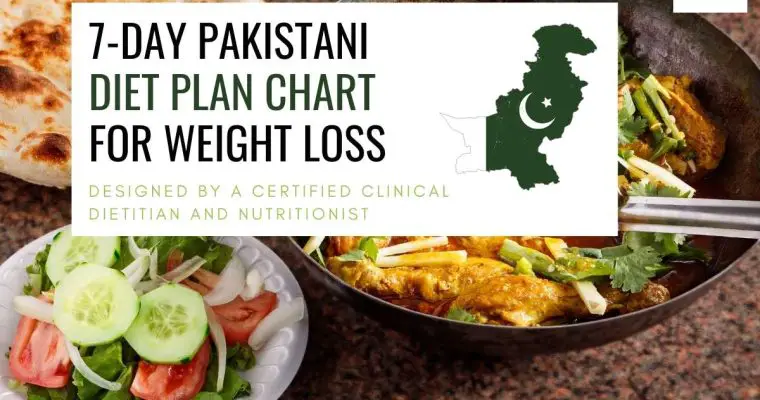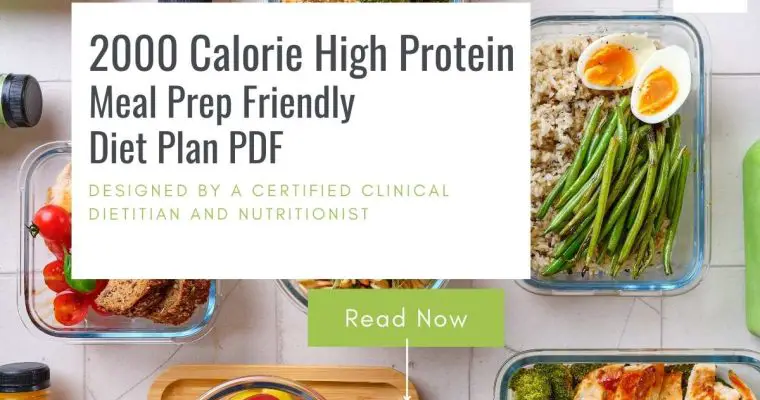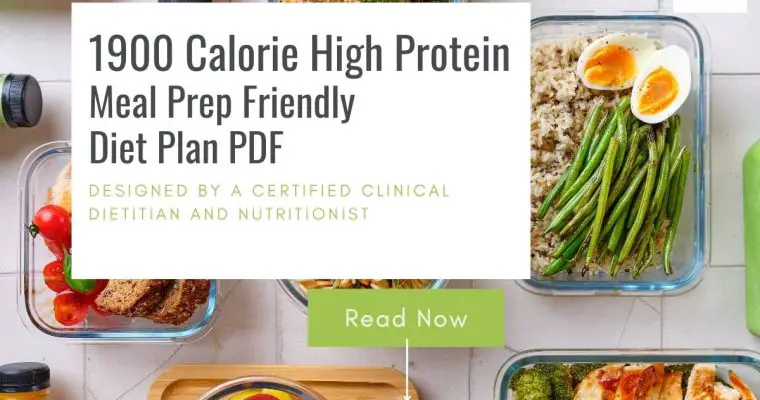1300 Calorie Diet Plan: Easy Weekly Meal Prep
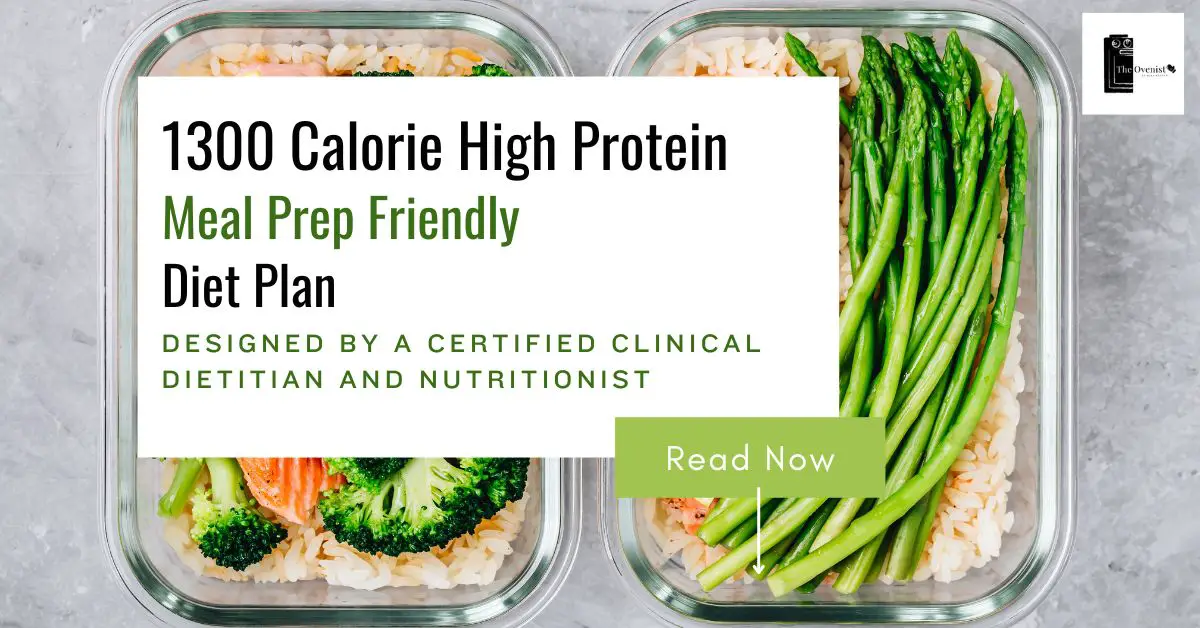
Imagine a plan that seamlessly combines the perks of meal prep, portion control, tasty recipes, the strength of protein, and a mindful approach to calories, all neatly bundled into one powerful package. That’s what this 1300 Calorie Diet Plan is all about.
So, let’s talk real talk…
The world of weight loss plans is a maze of choices, each claiming to be the magic potion you’ve been waiting for.
It’s tough to know where to put your money and trust. That’s where I come in.
I’m offering you a game-changer: low-calorie, free diet plans that are as accessible as they are effective. You’ve got nothing to lose, except maybe those extra pounds!
Embarking on a calorie-counting diet might seem daunting, but fear not. I present the solution right here:
What is a 1300 Calorie Meal Plan?
A 1300-calorie meal plan is a diet plan designed to provide you with approximately 1300 calories a day.
It is generally considered to be a low calorie plan which creates a calorie deficit, and hence you start to shed excess pounds over time.
Let me explain how that happens.
How does a 1300 calorie diet work?
Low calorie meal plans such as this create a calorie deficit, like I just mentioned.
A calorie deficit occurs when you consume fewer calories than your body expends over a certain period of time. In other words, you are burning more calories than you are taking in through your diet.
This is a fundamental concept in weight loss, as creating a calorie deficit is necessary for your body to tap into its stored energy (in the form of fat) to make up for the energy shortfall.
When you consistently maintain a calorie deficit, your body starts using its stored fat as a source of energy, which leads to weight loss over time.
This is because your body needs a certain amount of energy (calories) to perform its daily functions, including basic metabolic processes, physical activity, and even digesting food.
So that’s how 1200-1300 calorie plans can be an effective tool for weight loss.
However, they do provide a limited number of calories compared to the average daily caloric intake for many individuals.
Calorie Deficit Breakdown
- Caloric Intake: You consume calories through the food and beverages you consume.
- Caloric Expenditure: Your body burns calories through various activities, such as exercising, walking, performing daily tasks, and even just maintaining basic bodily functions (basal metabolic rate).
- Calorie Surplus vs. Calorie Deficit: If you consume more calories than your body burns, you’re in a calorie surplus, and the excess calories are stored as fat. If you consume fewer calories than your body burns, you’re in a calorie deficit, and your body starts using stored fat for energy.
- Weight Loss: Consistently maintaining a calorie deficit over time leads to weight loss as your body burns its fat reserves to meet its energy needs.
Who needs a a low calorie weight loss diet?
- Overweight or Obese Individuals: Those looking to shed excess body weight.
- Health Concerns: People with conditions like diabetes, heart disease, or high blood pressure.
- Preventive Measures: Individuals aiming to prevent health issues related to obesity.
- Postpartum Women: Women seeking to lose pregnancy-related weight (with medical advice).
- Event Preparation: People preparing for special occasions or events (e.g a wedding)
- Weight-Dependent Athletes: Athletes in sports where weight matters.
- Supervised Medical Cases: Severely obese individuals under medical supervision.
- Health and Wellness Enthusiasts: Those pursuing overall well-being.
However, it’s important to note that individual caloric needs vary based on factors such as age, gender, activity level, metabolism, and health goals.
Consulting with a healthcare professional or registered dietitian can help determine if a 1300-calorie plan is appropriate for your specific needs and goals.
About My 1300 Calorie Diet Plan: Easy Weekly Meal Prep
1. Completely Free
If you’re tired of shelling out your hard-earned cash on weight loss plans that promise the moon and stars, only to leave you hanging, I’ve got news for you. My commitment to your journey is crystal clear – all the meal plans you’ll find here are completely free.
Yes, you read that right – no hidden fees, no subscription traps. I’m here to empower you, and that includes your wallet!
2. Convenient Meal Prep
Life can get busy, especially for all the incredible moms and individuals juggling hectic schedules.
I understand that diving into a calorie-counting frenzy might seem like a leap. So, why not make it a smooth glide instead? Enter Meal Prep Diet Plan
The calories and nutrition information for the recipes are carefully calculated, and meal prep instructions are given (wherever applicable) throughout the plan.
By strategically planning your meals in advance with a meal prep approach, you’ll not only curb impulsive eating but also master portion control, setting you up for success.
3. Simplicity & Transparency
My 1300 calorie meal plan pdf is elegantly laid out, leaving no room for confusion.
With comprehensive breakdowns of breakfast, lunch, dinner, and snacks, you’ll always be in the know.
I go the extra mile by providing nutritional information for each meal and the overall macronutrient balance for the day.
All of the information is very precisely calculated using USDA Food Central Database, which is what makes this 1300 calorie meal plan for weight loss so effective.
4. Thoughtful Tasty Recipes
I believe in keeping motivation high, and what better way than through delicious recipes that won’t derail your progress? Who can stay consistent on bland, boring diet plans, anyway?
The recipes in the plan below are not only flavorful but also modified to fit seamlessly into your low-calorie meal prep regimen. Detailed instructions are at your fingertips, making cooking a breeze even for beginners.
5. Flexibility in Meal Plans
Alright, let’s talk flexibility.
You will notice that the plans are sorted from week 1 to week 4, but you don’t have to stick to that order like glue. I get that eating the same thing for a whole week can be as exciting as watching paint dry.
So, you’ve got options!
Feel free to shuffle between these four meal plans as they all provide a similar calorie and protein count. It’s all about what you’ve got hanging out in your pantry, or simply what your taste buds are craving that day.
Hold on…
I’m not stopping there. If you would like even more variety while keeping the same calorie and protein game strong, head over to my 1300 calorie high protein plan which brings four more unique meal plans to the table. It’s like a cousin to this one, but with a twist – different recipes that’ll tantalize your taste buds (no meal prep advice in it though).
Now that means, a grand total of eight plans that you can mix and match to your heart’s content. Monotony, who?
With this much variety, there’s no chance you’ll be yawning at your plate…(Or at least I hope).
6. Flexibility in Calorie Limit
Let’s say you’re looking for all these benefits, and these meals, BUT, a 1300 calorie is not your goal. If that’s the case, you can try:
- 1200 Calorie Meal Prep Friendly Diet Plan
- 1300 Calorie Meal Prep Friendly Diet Plan
- 1400 Calorie Meal Prep Friendly Diet Plan
- 1500 Calorie Meal Prep Friendly Diet Plan
- 1600 Calorie Meal Prep Friendly Diet Plan
This meal plans set has different meals compared to the set above:
- 1200 Calorie High Protein Meal Plan
- 1300 Calorie High Protein Meal Plan
- 1400 Calorie High Protein Meal Plan
- 1500 Calorie High Protein Meal Plan
- 1600 Calorie High Protein Meal Plan
Safety
Is a 1300 Calorie Diet Safe?
- A 1300-calorie diet is safe, especially when used as part of a short-term weight loss plan.
- You may want to consult a healthcare professional or registered dietitian before starting any low-calorie diet, as it might not provide enough energy for everyone’s needs.
Weight Loss
Can I lose weight on a 1300-calorie diet?
- A 1300-calorie diet can lead to effective weight loss as it typically creates a calorie deficit.
- Such a low calorie meal plan provides fewer calories than your body burns.
- Weight loss occurs when your body taps into its fat reserves for energy.
Exercise
Is it okay to exercise on a 1300-calorie diet?
- Moderate exercise can complement a 1300-calorie diet, but it’s crucial to listen to your body.
- Make sure you’re still providing your body with enough fuel to support your activity level.
- If you’re engaging in intense workouts, consider adjusting your calorie intake accordingly.
1300 Calorie Meal Plan Menu with Easy Weekly Meal Prep
Let’s go over the tasty, yet low calorie recipes for weight loss that are in store for you.
Week 1
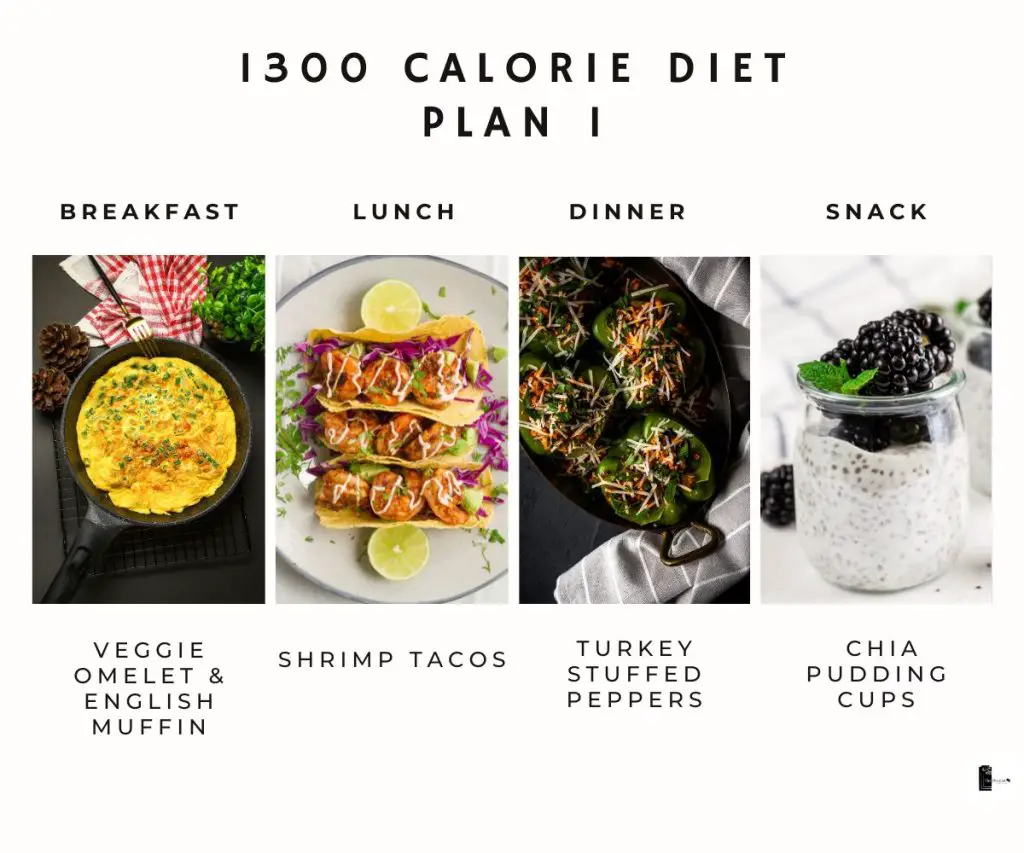
Breakfast: Veggie Omelet with English muffin
The Mushroom and Spinach Egg Scramble/Omelet with English Muffin provides a protein-packed breakfast with eggs and multigrain muffin for sustained energy. Rich in fiber, vitamins, and antioxidants from vegetables like spinach and mushrooms, it supports digestion, immunity, and overall health. Additionally, the inclusion of healthy fats and controlled calories make it a well-rounded choice for weight management.
Lunch: Shrimp Tacos
My low calorie healthy shrimp taco recipe offers a protein-rich meal with minimal fat due to the use of lean shrimp and a small amount of olive oil. Packed with flavorful spices like garlic, onion, paprika, cumin, and chili powder, they provide a burst of taste without excess calories. Using a carb balance tortilla wrap and fat-free sour cream ensures a balanced carbohydrate and fat profile, making these tacos suitable for any meal.
Dinner: Turkey Stuffed Peppers
These turkey stuffed peppers recipe is features lean ground turkey for protein, cooked wild rice for fiber, and a variety of vegetables for vitamins and minerals. With minimal saturated fat from fat-free cheddar cheese, it offers a tasty, cheesy meal that supports muscle health, fullness, and overall nutrition.
Snack: Chia Pudding Cups
Chia pudding cups offer a nutritious treat with their rich omega-3 content from chia seeds and low-calorie, fiber-rich berries. The combination of chia seeds, skimmed milk, and natural sweeteners provides a source of healthy fats, protein, and energy-sustaining carbohydrates, making it a wholesome and satisfying snack option.
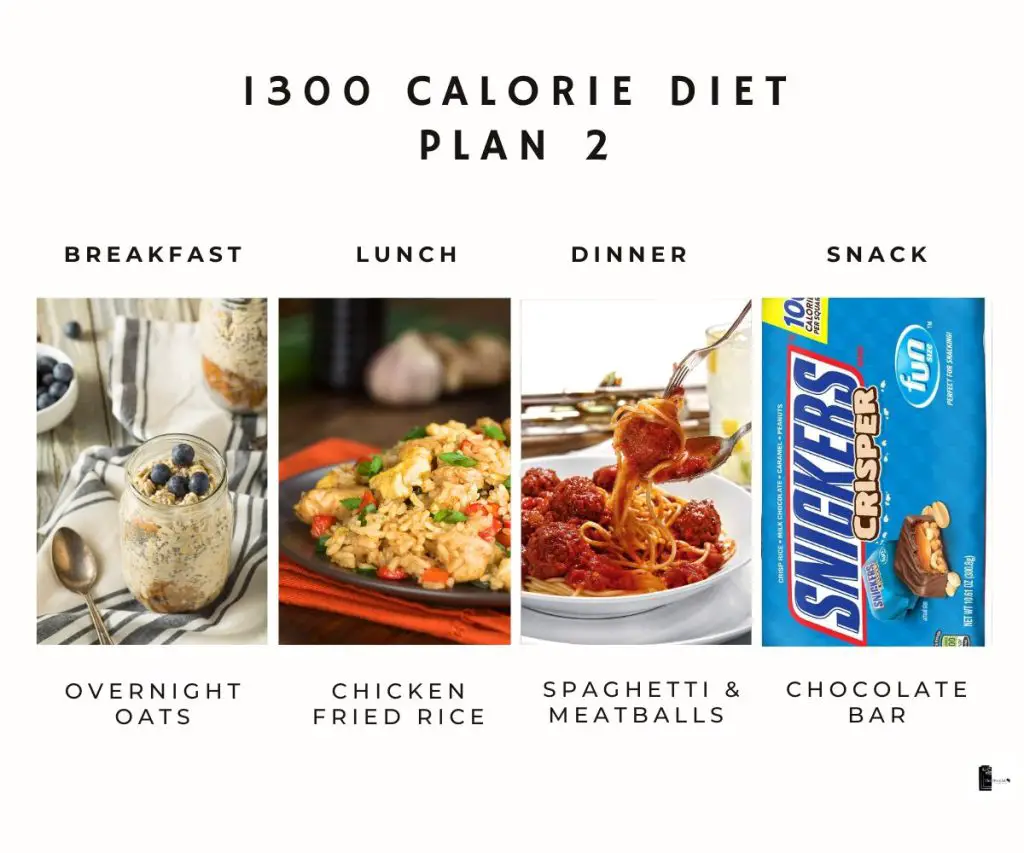
Week 2
Breakfast: Overnight Oats
These overnight oats offer nutritional benefits through their blend of whole grain oats, protein-rich almond milk, and vanilla protein powder, ensuring complex carbohydrates and sustained energy. The addition of fresh blueberries provides antioxidants, fiber and vitamins, enhancing both flavor and health benefits in this convenient breakfast.
Lunch: Chicken Fried Rice (Not really fried!)
This chicken fried rice dish offers nutritional benefits with its combination of lean protein from boneless chicken breast and fiber-rich, nutrient-packed brown rice. The inclusion of ginger and garlic provides potential immune-boosting properties, while the colorful mix of frozen peas and carrots adds vitamins and antioxidants. The recipe’s careful use of oil or cooking spray ensures a controlled amount of healthy fats, making this meal a balanced and flavorful option for protein, complex carbohydrates, and essential nutrients.
Dinner: Spaghetti & Meatballs
Low-calorie, high-protein spaghetti and meatballs dish offers nutritional benefits through its lean ground beef, which provides a substantial source of protein while being lower in fat. The incorporation of Barilla Tomato and Basil sauce contributes essential vitamins and antioxidants, while the choice of Barilla Protein Spaghetti increases the protein content of the meal. The balanced use of herbs and spices adds flavor without excessive calories, making this recipe a satisfying and health-conscious option for a protein-packed pasta dish.
Snack: Chocolate Bar (Yes, you can have that on a weight loss diet!)
As a snack, consider enjoying either a Snickers Fun Size Crisper bar (21g) or a Dove Silky Smooth Milk Chocolate bar (0.65 oz/18.4g). These options are included to cater to those cravings! It’s perfectly acceptable to incorporate such treats within a weight loss or healthy eating plan, provided they’re thoughtfully integrated into your overall daily nutritional intake. In fact, these indulgences can help prevent feelings of deprivation, fostering a more consistent and sustainable approach to your dietary journey.
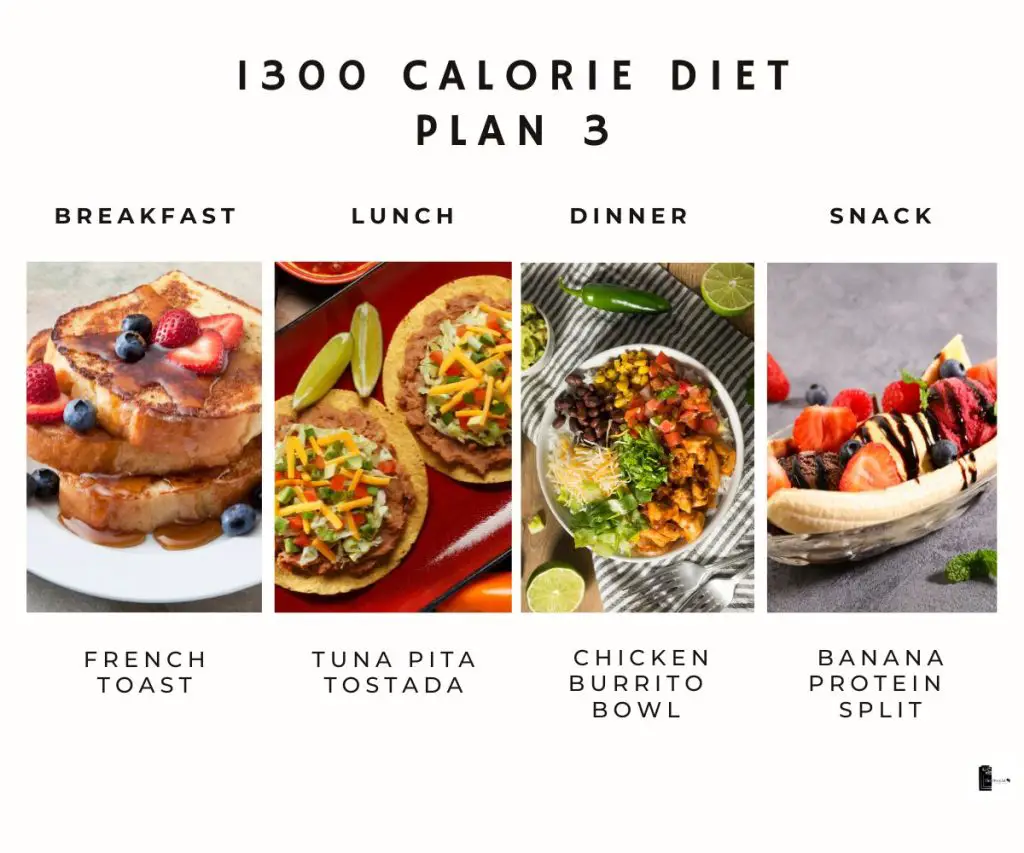
Week 3
Breakfast: French Toast
This healthy low-calorie French toast recipe provides a nutritious breakfast option. Made with multigrain bread, it offers whole grains and dietary fiber, while the combination of almond milk and egg supplies quality protein. The addition of strawberries adds vitamins and antioxidants, and by avoiding oil and butter in the cooking process, the recipe keeps fat consumption low.
Lunch: Tuna Pita Tostada
With a base of Joseph’s Flax, Oat Bran & Whole Wheat Pita, it provides whole grains, protein and dietary fiber. The inclusion of light tuna, rich in lean protein but low in calories, adds to its nutritional value, while the addition of red onion, lime juice, and herbs offers antioxidants and flavor without added salt. The meal is served with fat-free sour cream and you can also bake the pita for some crunch.
Dinner: Chicken Burrito Bowl
This low-calorie, healthy chicken burrito bowl combines lean protein from boneless, skinless chicken breast, fiber-rich vegetables like red bell pepper and onion, and whole grains from brown rice for a balanced and satisfying meal. Incorporating nutrient-dense ingredients such as black beans, corn, and salsa, while minimizing added fats with cooking spray and fat-free cheese, makes it a great dinner that offers protein, fiber, vitamins, and flavor.
Snack: Banana Protein Split
The healthy banana protein split combines the natural sweetness and fiber of a small banana with protein-packed Oikos Non Fat Greek Yogurt and vanilla protein powder, topped with the ever-loved strawberry.
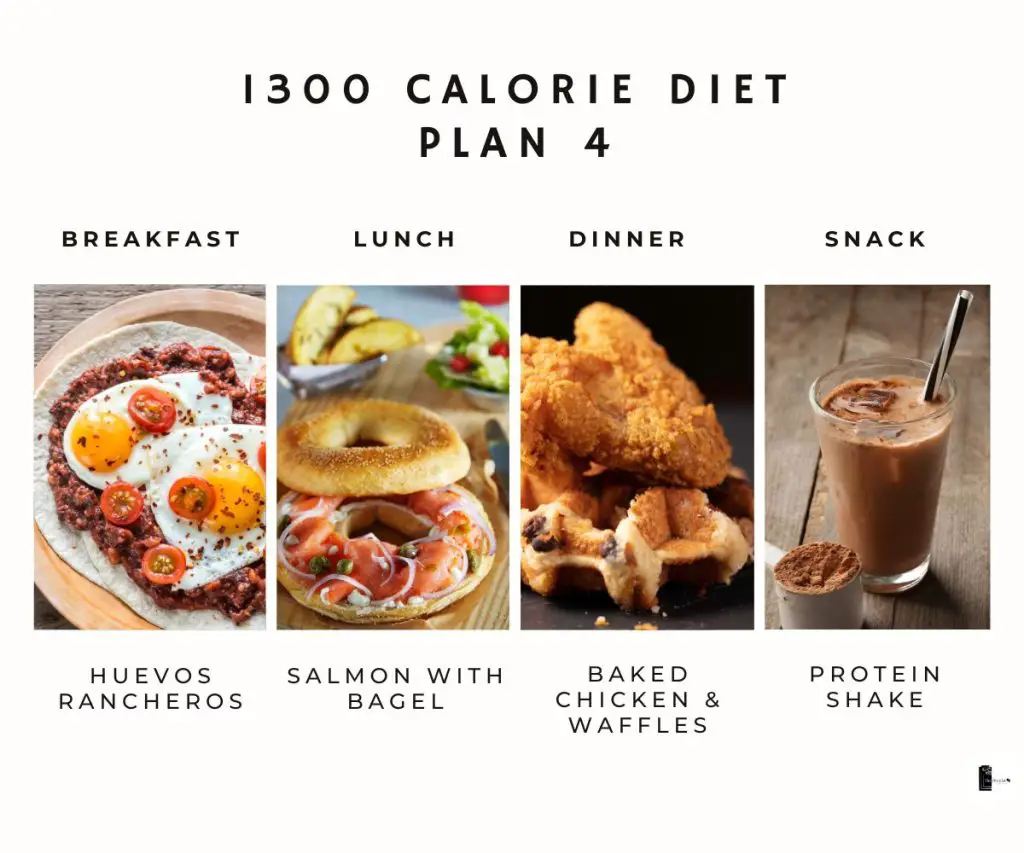
Week 4
Breakfast: Huevos Rancheros
This healthy low-calorie huevos rancheros dish combines protein-rich large egg with fiber-loaded Mission Carb Balance Flour Soft Taco and Goya black beans for a balanced breakfast. The inclusion of fresh salsa, cilantro, and controlled use of olive oil maintains flavor while providing vitamins, antioxidants, and a healthful fat profile.
Lunch: Salmon with Bagel
This salmon with bagel dish boasts omega-3-rich pink salmon for heart health, paired with a whole-grain Thomas Bagel Thin for fiber and sustained energy. The use of cajun seasoning adds flavor without excess sodium, while cooking the salmon in its natural oils aligns with a low calorie approach.
Dinner: Baked Chicken & Waffles
This modified low-calorie healthier baked chicken and waffles recipe offers lean protein from boneless chicken breast, whole grains from Kodiak Carb Conscious Waffles Mix, and reduced saturated fats by baking the chicken and using corn flakes. The use of Cary’s Sugar Free Low Calorie Syrup and unsweetened almond milk maintains controlled sugars, resulting in a lower version of a beloved comfort food.
Snack: Protein Shake
This protein shake combines the protein-rich benefits of Teddies All Natural Peanut Butter and vanilla protein powder for muscle support and satiety. Blended with unsweetened almond milk, it offers a nutrient-dense option that includes healthy fats and vitamins, perfect for a balanced and satisfying beverage.
Carb, Protein & Fat Sources in This Plan
Most of the low calorie recipes for weight loss that I designed for this plan are made from the best quality protein, nutritious multi-grain carbs and healthy fat sources.
High Quality Protein
You’re probably well aware of the crucial role that high-quality protein plays in kickstarting weight loss through various mechanisms. And when it comes to a low-calorie, high-protein meal plan, the spotlight is on top-tier protein sources – just as I’ve carefully curated here:
Eggs: With a treasure trove of high-quality protein and essential amino acids, eggs are an undeniable star. Not only do they bolster feelings of fullness, but they also curtail calorie consumption over the day.
Shrimps: These bite-sized wonders bring low calories and high protein to the table. Their lean profile isn’t just about muscle growth; it also supports maintaining a revved-up metabolic rate.
Ground Lean Turkey: A heavyweight in protein content, lean turkey packs a punch while keeping fat content to a minimum. It’s a muscle-preserving champ, perfectly aligned with your calorie-conscious endeavors.
Zero-Fat Greek Yogurt: Beyond being a probiotic powerhouse for gut health, Greek yogurt is a force to be reckoned with in the protein realm. Its creaminess and protein-packed nature make sure you’re not left wanting.
Low-Fat Regular Milk or Almond Milk: Whether you go dairy or opt for almond milk, both choices bring a protein boost while taming the saturated fat. These proteins wield their magic in appetite management and potentially stave off overindulgence.
Chicken Breast: Lean, mean, and protein-packed, chicken breast takes center stage in muscle-building. Its impressive protein-to-calorie ratio steps up your satisfaction game – a must-have in any noteworthy weight loss plan.
Lean Ground Beef (97% lean, 3% fat): Lean beef doesn’t just bring protein to the table; it’s also rich in vital nutrients like iron, seamlessly aligning with a low calorie meal plan.
Canned Light Tuna: For those looking to maintain muscle mass while shedding pounds, canned light tuna is a lean, protein-rich ally. Its minimal calorie load keeps the scale tilted in your favor.
Protein Powder: When convenience meets protein goals, protein powder steps in. A powerful tool in your 1200-calorie protein diet arsenal, protein shakes can play the roles of satiating snacks or even meal replacements, giving you a firm grip on calorie control.
Salmon: This delightful fish isn’t just about protein; it also brings in those heart-healthy omega-3 fatty acids. These healthy fats not only support overall well-being but also have the potential to regulate your appetite.
With these high-quality protein sources as your foundation, you’re arming yourself with the building blocks of a successful weight loss journey. Each choice in this 1300 calorie diet meal plan not only aids your goals but also adds a burst of flavor and variety to your plate.
High Quality Carbs
- Light Multigrain English Muffins
- Low Carb Tortillas
- Wild & Brown Rice
- Fresh Fruits berries
- Whole grain old fashioned rolled oats
- Protein Spaghetti
- Multigrain Bread
- Flax, Oat Bran and Whole Wheat Pita
- Low Carb High Protein Bagel Thins
Healthy Fats
- Olive Oill
- Canola Oil
- All Natural Peanut Butter
1300 Calorie Meal Plan Pdf
Here’s the low calorie meal plan that will provide you 130-132g of protein and 1300 calories a day.
Note
It’s important to note that while a calorie deficit is essential for weight loss, extreme deficits can have negative effects on your metabolism, muscle mass, and overall health.
It’s recommended to aim for a moderate calorie deficit that allows for gradual, sustainable weight loss.
This is why I offer meal plans with a wide range of calories so you can choose what works best for you:
- 1200 Calorie (Low Calorie Meal Plan)
- 1300 Calorie Meal Plan For Weight Loss
- 1400 Calorie Healthy Plan
- 1500 Calorie Healthy Plan
- 1600 Calorie Healthy Plan
Weight Loss Tips
These tips can support effective weight loss in a low calorie high protein diet.
What’s next?
So, let’s say you’ve dived into this 1300 calorie high protein diet, and it’s clicking for you – that’s awesome!
But, what’s next?
Or perhaps the this calorie range doesn’t quite hit the mark for you.
Well, connect with me!
I’m here to offer additional plans similar to this one, or I can create custom-tailored options that sync perfectly with your favorite foods and personal preferences.
And no, I’m not stopping at the usual suspects like fruits, veggies, meats, seafood, dairy, and grains.
I’m all about crafting full meals that dance to the rhythm of your cultural inclinations.
I believe that’s a boost your dedication needs, and I’m here to guide you every step of the way.
Need A Customized Plan?
GET IN TOUCH
Don’t hesitate to contact me regarding any queries you might have about a low-calorie, high-protein meal plan.
I’m excited to design a meal plan that ticks all your boxes – from foods you relish, to staying within your budget and the confines of what’s available to you. Let’s embark on this flavorful journey together!
FAQs
Supplements
Should I take supplements on a 1300-calorie diet?
- Whole foods should be your primary source of nutrients.
- While a balanced diet can usually meet your needs, certain vitamins and minerals might need supplementation, especially if advised by a healthcare professional.
Suitability
Is a 1300-calorie diet suitable for everyone?
- A 1300-calorie diet might not provide enough calories to meet long-term energy needs for many individuals, especially those with higher activity levels.
- Pregnant or breastfeeding women, growing teenagers, and individuals with certain medical conditions might require more calories.
Tracking Progress
How should I track my progress on a 1300-calorie diet?
- Tracking progress can involve more than just the scale.
- Monitor how your clothes fit, your energy levels, and any changes in your body composition.
- Regular check-ins with a healthcare professional can provide a comprehensive picture of your progress.
What foods should I focus on in a 1300-calorie diet?
Opt for nutrient-dense foods that provide essential vitamins, minerals, and macronutrients. Focus on lean proteins, whole grains, fruits, vegetables, and healthy fats. This will help you meet your nutritional needs even on a lower calorie intake.
Will I feel hungry on a 1300-calorie diet?
Hunger might be more noticeable on a lower-calorie diet, especially at the beginning. Choosing fiber-rich foods, drinking plenty of water, and eating small, frequent meals can help manage hunger. Try low calorie recipes for weight loss, such as the ones in this plan.
Will a 1300 calorie diet meal plan provide enough nutrients?
A well-balanced 1300-calorie diet that includes a variety of whole foods can provide essential nutrients. However, there’s a potential for nutrient deficiencies if not carefully planned. Incorporating a range of colorful fruits, vegetables, lean proteins, whole grains, and healthy fats can help meet your nutritional needs.
How often should I eat on a 1300-calorie diet?
Eating patterns can vary, but spreading 1300 calories a day across three main meals and a couple of snacks can help manage hunger and provide sustained energy throughout the day.
How long can I stay on a 1300 calorie diet meal plan?
The duration of a 1300-calorie diet depends on your goals, health, and individual factors. It’s generally recommended to transition to a more sustainable eating plan once your weight loss goals are met. Long-term calorie restriction can impact metabolism and overall health.
What can I do if I hit a weight loss plateau on a 1300 calorie diet?
Plateaus are common during weight loss journeys. You can try adjusting your exercise routine, changing up your meal plan, or even slightly increasing your calories for a short period to boost your metabolism. Consult a professional for personalized advice.
Can I still enjoy treats or indulgences on a 1300 calorie diet plan?
Moderation is key. While it’s important to focus on nutrient-dense foods, occasional treats can be included within your calorie budget. Just be mindful of portion sizes and how often you indulge.
Can I customize a 1300-calorie diet plan to my preferences?
Absolutely! The key to success is finding a plan that suits your taste preferences, cultural background, and dietary needs. While keeping calorie intake in mind, you can adapt your meals to include foods you enjoy and that meet your nutritional requirements.
Looking For More?
-
Pakistani Diet Plan Chart | 7-Day Printable Meal Plan
This Pakistani Diet Plan Chart offers a 7-day printable meal plan that combines traditional Pakistani flavors with healthy, low-calorie meals to help you achieve your weight loss goals This 7-day meal plan provides a balanced approach to healthy eating while maintaining flavor and traditional Pakistani…
-
2000 Calorie Diet | 2000 Calories Calories A Day Meal Plan PDF
2000 Calorie Meal Prep Diet Plan – A High Protein, Deliciously Satisfying Guide Welcome to the 2000 Calorie Meal Prep Diet Plan. It has been carefully crafted by a dietitian to help you reach your fitness and weight loss goals. There’s no need to compromise…
-
1900 Calorie Meal Plan High Protein PDF
Looking for a structured, nutritious, and protein-rich meal plan to support your health and fitness goals? Our 1900 Calorie High Protein Meal Plan PDF is designed specifically for those who want to enjoy satisfying, high-protein meals while sticking to a calorie-controlled diet. Perfect for individuals…
“To those following my diet plans, a heartfelt thanks for your dedication to health. While adjusting your lifestyle might be challenging, remember you’re not alone. I’m here to support you at every step.
Approach this journey with self-compassion; progress, not perfection, matters. Embrace challenges as learning opportunities, and celebrate achievements, no matter how small. Stay committed, and know I’m cheering you on!”
Weight Loss: How Many Calories Do I need?
Step 1: Finding Your Calorie Needs
The Mifflin-St Jeor equation helps you figure out how many calories you need when you’re just resting. This is called your “Basal Metabolic Rate” or BMR.
For Men:
BMR = (10 * your weight in kg) + (6.25 * your height in cm) – (5 * your age in years) + 5
For Women:
BMR = (10 * your weight in kg) + (6.25 * your height in cm) – (5 * your age in years) – 161
Step 2: Adding Activity
Your daily activities burn more calories than just lying around. To get a better idea of how many calories you burn overall, multiply your BMR by a number based on how active you are:
- Sedentary (not much activity): BMR * 1.2
- Lightly active (some exercise, 1-3 days a week): BMR * 1.375
- Moderately active (exercise, 3-5 days a week): BMR * 1.55
- Very active (exercise a lot, 6-7 days a week): BMR * 1.725
- Super active (intense exercise, physical job): BMR * 1.9
Step 3: Weight Loss
If you want to lose weight, you need to eat fewer calories than your body uses. Cutting around 500 to 1000 calories a day can help you lose about 1 to 2 pounds a week – a healthy pace.
So, take your BMR, multiply it by your activity factor, and then subtract 500 to 1000 calories. This gives you a target for how much to eat each day.
